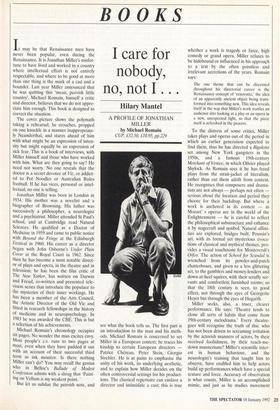BOOKS
I care for nobody,
no, not I . • •
Hilary Mantel
A PROFILE OF JONATHAN MILLER by Michael Romain CUP, £32.50, f10.95, pp.229 It may be that Renaissance men have never been popular, even during the Renaissance. It is Jonathan Miller's misfor- tune to have lived and worked in a country where intellectual effort is not entirely respectable, and where to be good at more than one thing is the mark of a cad and a bounder. Last year Miller announced that he was quitting this 'mean, peevish little country'. Michael Romain, himself a critic and director, believes that we do not appre- ciate him enough. This book is designed to correct the situation.
The cover picture shows the polymath taking a rehearsal; he crouches, propped on one knuckle in a manner inappropriate- ly Neanderthal, and stares ahead of him with what might be an expression of inten- sity but might equally be an expression of sick fear. This is a book of interviews, with Miller himself and those who have worked with him. What are they going to say? He need not worry. No one reveals that the doctor is a secret devotee of Viz, or addict- ed to Pot Noodles or Australian Rules football. If he has vices, personal or intel- lectual, no one is telling.
Jonathan Miller was born in London in 1934. His mother was a novelist and a biographer of Browning. His father was successively a philosopher, a neurologist and a psychiatrist. Miller attended St Paul's school, and at Cambridge read Natural Sciences. He qualified as a Doctor of Medicine in 1959 and came to public notice with Beyond the Fringe at the Edinburgh Festival in 1960. His career as a director began with John Osborne's Under Plain Cover at the Royal Court in 1962. Since then he has become a most notable direct- or of plays and opera, in the theatre and in television; he has been the film critic of The New Yorker, has written on Darwin and Freud, co-written and presented tele- vision series that introduce the populace to the mysteries of their inner workings. He has been a member of the Arts Council, the Artistic Director of the Old Vic and fitted in research fellowships in the history of medicine and in neuropsychology. In 1983 he was awarded the CBE. This is but a selection of his achievements.
Michael Romain's chronology occupies six pages. No wonder the man excites envy. Most people's c.v. runs to two pages at most, even when they have padded it out with an account of their successful third
term as ink monitor. Is there nothing Miller can't do? You may recall the genius who in Belloc's Ballade of Modest C. onfession admits with a shrug that 'Paint- ing on Vellum is my weakest point. '
But let us subdue the peevish note, and see what the book tells us. The first part is an introduction to the man and his meth- ods. Michael Romain is concerned to set Miller in a European context; he traces his kinship to certain European directors Patrice Chereau, Peter Stein, Giorgio Strehler. He is at pains to emphasise the unity of his work, its underlying aesthetic, and to explain how Miller decides on the often controversial settings for his product- ions. The classical repertoire can enslave a director and intimidate a cast; this is true whether a work is tragedy or farce, high comedy or grand opera. Miller refuses to be hidebound or influenced in his approach to a text by the often pointless and irrelevant accretions of the years. Romain says:
The one theme that can be discerned throughout his directorial career is the Renaissance concept of 'renovatio,' the idea of an apparently ancient object being trans- formed into something new. This idea reveals itself in the way that Miller's work startles an audience into looking at a play or an opera in a new, unexpected light, so that the piece itself is refreshed in the process.
To the distress of some critics, Miller takes plays and operas out of the period in which an earlier generation expected to
find them; thus he has directed a Rigoletto
set among New York gangsters in the 1950s, and a famous 19th-century
Merchant of Venice, in which Olivier played Shylock. As Romain sees it he has freed plays from the strait-jacket of literalism, rather than cut them adrift from context. He recognises that composers and drama- tists are not always — perhaps not often serious about the location and period they choose for their backdrop. But where a work is anchored in its context — as Mozart' s operas are in the world of the Enlightenment — he is careful to reflect the philosophical substructure and enhance it by stagecraft and symbol. Natural affini- ties are explored, bridges built. Poussin's art, with its formal yet mysterious evoca- tions of classical and mythical themes, pro- vides a visual touchstone for Monteverdi's Orfeo. The action of School for Scandal is wrenched from its powder-and-patch chatterboxes, and given to a less glittering set, to the gamblers and money-lenders and down-at-heel squires, with their scruffy ser- vants and comfortless furnished rooms; so that the 18th century is seen, to good effect, not through the eyes of Georgette Heyer but through the eyes of Hogarth. Miller seeks, also, a truer, clearer performance. He says: 'Theatre tends to clone all sorts of habits that come from 19th-century melodrama.' Every theatre- goer will recognise the truth of this: who has not been driven to screaming irritation by the actorish manners of actors, by their received foolishness, by their reach-me- down mannerisms? Miller's scientific inter- est in human behaviour, and the neurologist's training that taught him to observe, have enabled him to help actors build up performances which have a special texture and force. Accuracy of observation is what counts. Miller is an accomplished mimic, and just as he studies movement
and gesture in real life he also seeks for the rhythms of ordinary speech, making use of those 'rules' of conversation we all obey but don't think about; just as overlapping and interrupting is sometimes permissible in real life, it may be permissible in the theatre.
Romain shows how Miller's lively and educated visual sense feeds into his art; he uses paintings, drawings or photographs to convey to his designer and his cast the look he is after, the mood he wants to evoke. More, he uses them to show the spirit of an era. He seeks to cultivate, Romain says, a 'balance between text and image'. He prefers to work with older texts because the 'interpretive gap' is wider; this gap, by the breadth of his knowledge and sympathies, he is uniquely qualified to bridge.
The rest of Romain's book enlarges on these themes. In the second section, Miller himself is interviewed; in the third section Romain talks to designers, actors, singers and conductors who have worked with him.
There is inevitably some overlap and repetition, and the format often seems clumsy. Romain has to ask questions like this: 'How did you come to be involved in Jonathan's production of Robert Lowell's The Old Glory, which he directed at the American Place Theatre in 1964?'
There is so much information to be conveyed; the strain shows.
'How do you explain the remarkable suc- cess of your production of The Three Sisters in the West End in 1976?', Romain asks. Unfairly, no doubt, one hears the question posed in a tone of oily sycophancy.
For the testimony is unanimous. Miller is a joy to have around, he's no head-in- clouds intellectual but a practical chap who understands the problems of actors and singers, and who inspires them with confidence. He is no dictator but a sensitive co-operator. He takes risks; he never settles for the obvious. Readers must hope that among Miller's many attributes is the rare skill of accepting compliments gracefully.
He has not had much practice, of course. The critics have been after his blood since his early days as editor of the BBC's Monitor; it seems that Britain in 1964 was not ready for Susan Sontag, pop art, the culture of kitsch and camp. His approach was anathema to the mandarins; and always there are dark mutterings that Miller only directs the work of the dead because the dead cannot answer back. As for the public at large, they do not want their preconceptions challenged, and it has been easy to dismiss Miller's transpositions of texts as gimmicry. He has never been a restful director, or a crowd-pleaser: at the Old Vic, for instance, he chose to introduce an audience who liked their Ayckbourn to whatever delights are afforded by Racine's Andromache.
It is always Miller's function to set the philistine in a rage; but then, the Great British Philistine isn't what he was. The problem is now that small talent snaps at Miller's heels, offering cut-price profundity to the public, and 'design' as a substitute for thought. Miller may think of himself as outside the Establishment, but that does not prevent his notions becoming dogma. It would be refreshing, for instance, to hear nowadays of a production of Measure for Measure that made no reference, overt or covert, to Freud's Vienna, that derived Isabella's behaviour from a terror of hell rather than a terror of sex. Miller's atheism perhaps limits his sympathies; and one interviewee speaks of his 'innate scepticism and disbelief in romantic love or altruism'. Yet these are the passions — deeply wrong-headed, no doubt — that inspire so many of the characters in the work he directs, that motivate them, that govern their lives. Despite his comic flair — proba- bly because of it — Miller is a pessimist. Pessimism, in the intelligent and influen- tial, is more than a character trait; it can be a disabling, crippling intellectual vice. It leads to world-weariness, then to rejection of effort, then — nowhere. Will Miller one day speak not of this 'mean, peevish little country' but this mean, peevish little world? Those who need to be convinced of Miller's genius may be swayed by this book, but those who are already convinced may feel they want more: for surely the man is not simply his work? Why does he think as he does? What formed and shaped his mind, before Darwin and Karl Popper and Gombrich took a hold?
Meanwhile, we hear that, though Miller has stomped out on England, he will he back; he will be working with the ENO, and a production of Der Rosenkavalier is scheduled for early 1994. Scarcity value will no doubt raise his stock, and give his detractors an interval to file their teeth to points. Michael Romain will perhaps pro- duce another book about the next 20 years of his career. Well done so far, Mr Romain: but next time, ask more awkward questions, please.



















































 Previous page
Previous page